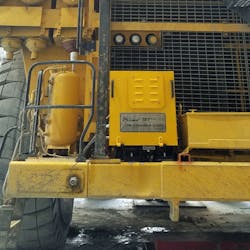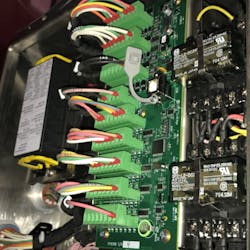Primo IAS Cuts Idling, Keeps Eqt Functions
An idle-reduction system is cutting fuel costs for mining trucks without stopping the truck's essential functions. Debra Johnson is CEO of Phoenix-based Eco-Edge, a company that works with equipment owners to improve overall fleet efficiency through the use of innovative technology. She says Eco-Edge has been installing the system on large haul trucks in a number of mining fleets during the past few years.
Primo IAS (Idle Alternative System) is designed, patented, and manufactured by sister company ECOmplete, and automatically shuts down the truck’s engine when appropriate (after a cool-down interval) and then maintains the function of the truck’s essential systems via an auxiliary power unit (APU).
The APU uses a small (13-horsepower) diesel engine, which draws only a half-gallon of fuel per hour from the truck’s tanks. In the basic IAS system, the APU drives an alternator to power the truck’s essential electrical functions (lights, radios, windows, for instance) and to charge the batteries. The APU also powers an air-conditioning compressor, which integrates with the truck’s evaporator to cool the cabin, and a pump that circulates engine coolant to heat the cabin.
The APU also can be fitted with controls, as wells as a compressor to maintain pressure in the truck’s air system (critical for units with air starters); a hydraulic pump for such functions as releasing the parking brake, charging steering accumulators, or raising the body of a truck with an inoperable engine; and a coolant heater for maintaining cabin heat over an extended shutdown interval or for warming the engine for restarting. The APU also can drive a power-take-off and can accommodate in-tank heaters for essential fluids. All of the major auxiliary systems are integrated into the truck’s on-board systems, allowing controls to function with no change.
“The purpose for integrating these systems is to provide an overall system that functions reliably, consistently, and most importantly, safely—while addressing concerns that equipment owners might have about shutting down one of these engines, such as operator comfort or restarting," Johnson says. "The system relieves the operator of having to decide when and where engine shut-down is appropriate, but also allows the operator to over-ride the system if the situation dictates.”
Why idle reduction benefits fleets
According to Johnson, a large haul truck in a mining operation typically idles about 30 percent of its total running time. At-idle fuel consumption, she says, based on figures Eco-Edge has validated with truck manufacturers, might range from 5 gallons per hour (gph) for a 100-ton-capacity model with 1,000 gross horsepower, to nearly 20 gph for a 400-ton-capacity model with 4,000 gross horsepower.
To illustrate the economic benefit of fuel savings by shutting down these huge engines when appropriate, Johnson cites data compiled during the validation phase of installing the IAS system in a fleet of 320-ton, electric-drive trucks, each running about 6,500 hours per year. The trucks were idling about 30 percent of total engine-running time, or about 1,950 hours per year.
“If we can reduce idling time by around 10 percent, to, say, 20 percent of total running time in this instance, that’s a practical goal,” says Johnson.
That 10-percent reduction, she says, would trim total idling time by 650 hours per year per truck. These machines, with 2,700-horspower engines, use about 12.5 gallons of fuel per hour at idle, so the 10-percent reduction in fuel usage results in significant gallons saved.
For some fleets, however, reducing idling time yields a greater benefit than saving fuel.
“For some mines,” says Johnson, “fuel savings from reducing idling time, as significant as they might be, are just a bonus that comes along with the real benefit of extending a truck’s engine life and productive operating time between major power-train rebuilds.”
According to Johnson, many fleets spread the cost of the anticipated rebuild, including downtime, over the truck’s life cycle, then add an appropriate figure to the truck’s annual cost of operation. Reducing idling trims that annual calculation significantly, she says, as does the reduction of the number of preventive-maintenance services required annually.
“We estimate that most mines see an ROI of about 9 to 12 months with the IAS system,” she says, “some basing ROI on power-train life extension, alone.”
Before equipping an entire fleet of trucks with the idle-reduction system, says Johnson, Eco-Edge will work with the site to “validate” the system’s performance in the operation by installing it on a sample number of machines, six domestically and 10 internationally.
“We start planning for installation about five months out, documenting idle time and fuel consumption in the operation, determining what parameters the mine considers to indicate idling, custom-designing the system, then using the validation phase to refine the installation process,” says Johnson. “Validation is like a dress rehearsal for a symphony. On a recent project, by the sixth truck during validation, were able to install a complete system in just one shift. We’ve learned that planning is critical. If a technology fails, it’s usually not the technology that’s at fault—but the execution of the technology.”
Eco-Edge’s plan for the Primo IAS system, says Johnson, is to extend its installation to mining shovels, and, as the economics allow, to scale the system for installation on wheel loaders and dozers. Further, plans are to equip the system with geo-fencing capability that would allow the system to recognize if the machine is in an area appropriate for engine shut-down.
“The technology involved in the Primo IAS system is challenging,” says Johnson, “but if it were easy, someone else would have done it.”

